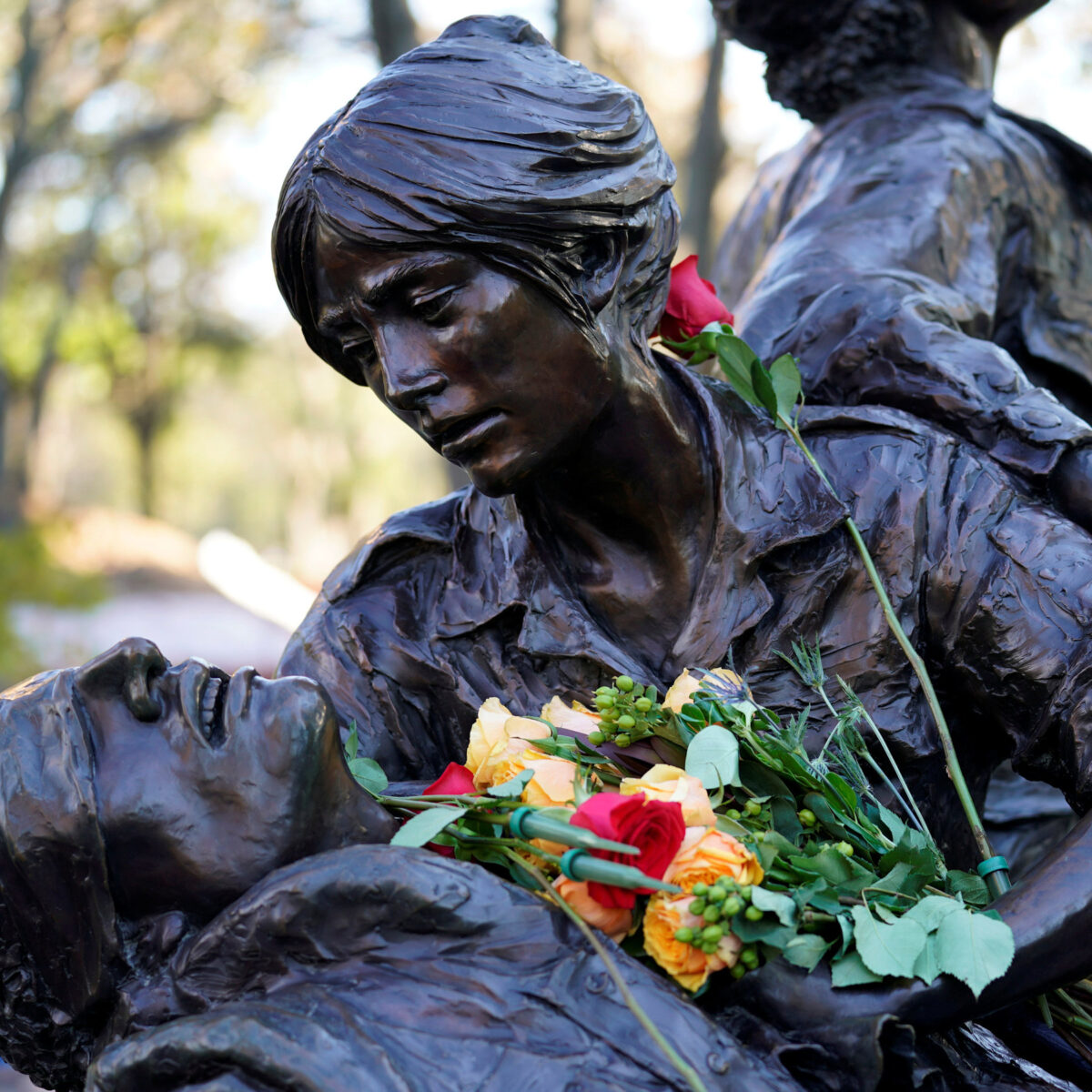The critics have faded into history. New generations are inspired. Women veterans of the Vietnam War, regardless of duty station or assignment, feel connected and appreciated, often after years of doubt.
These are among the effects of the Vietnam Women’s Memorial. Questioned, opposed and even ridiculed at the time of its genesis, the project took a decade of convincing and steadfast support from The American Legion to reach Nov. 11, 1993, and its nationally
televised dedication on the National Mall in Washington, D.C.
Thirty years later, the memorial – relentlessly spearheaded by Vietnam War combat nurse
a.nd American Legion member Diane Carlson Evans – was a cause to be celebrated during Veterans Day 2023 observances on the National Mall. As keynote speaker for the official Observance at the Wall, Carlson Evans reflected on the years leading up to the accomplishment.
“The journey began smoothly until the adversaries saw we were serious and began fighting us at every step,” she told a crowd of hundreds, including American Legion National Vice Commander Mark Shreve. “Mahatma Gandhi said, ‘First they ignore you.’ They did.
‘Then they laugh at you.’ They did. ‘Then they fight you.’ They did. ‘Then you win.’ That’s our 10-year story. We won.”
She noted that the road to dedication was often rocky, but “looking back on those 10 years, I remember we never gave up on a patient in Vietnam, (and) we’ll never give up on honoring and remembering all those in the military who served and sacrificed. We knew how to get a job done.”
Women who were not yet born at the time ofthe Vietnam War spoke of how the memorial has inspired them. “The women who served in the Vietnam War played a vital role in helping the country to change and grow,” Army Capt. Danielle Craig said during a Nov. 10 candlelight ceremony. “They showed that women could serve in other capacities, such as combat roles. They also helped break down barriers and stereotypes about women. The women of the Vietnam War are role models for us all. They showed us that we can make a difference in the world, no matter our gender or background.”
Army Col. Courtney M. Sugai, whose uncle was a Vietnam War medic and father was a veteran of the war, expressed her thanks “for the freedom earned by my ancestors and … for the opportunity to challenge myself, to dream and to achieve. As you lCJ’®k at the faces on the bronze figures of this Vietnam Women’s Memorial, they don’t have the same facial expressions you see on other memorials on the National Mall. They are not 30 feet tall. They are not mounted on a horse. They are not standing heroically on top of a pedestal. Their expressions are a combination of compassion, grit, grief and hope.”
She described the statue sculpted by Glenna Goodacre, who died in 2020, as a “memorial to real women, who looked ordinary on the outside but were bolder and braver than they had to be, and stronger than most wanted them to be. I have visited this memorial several times over the course of my Army career. Whether I visited on Veterans Day or Memorial Day, or stopped by while jogging, I am continually inspired … because of how it connects me to warriors of the past, who paved the way for soldiers like me …. I am a combat veteran of 23 years. I am inspired by these women’s refusal to surrender and grateful for their relentless fight for the honor they deserved. Your legacy lives in us.”
Jeff Reinbold, superintendent of the National Mall and memorial parks for the National Park Service, told the crowd the memorial has been a major attraction. “Thirty years ago, visitation on the National Mall was 4 million. Today, we are at 36 million …. Sacred sites like the Vietnam Women’s Memorial and the Vietnam Veterans Memorial promote a spirit of unity and remembrance, giving all of us a place to ecognize those who have served, and those who continue to serve, our great nation.”
Among the names on the Wall are eight belonging to women who lost their lives in the war. The Vietnam Women’s Memorial honors the 10,000-plus who served in-country as well as more than 265,000 women who served around the world at the time, military and otherwise.
Linda Pugsley, a pastor and chaplain who served as an Air Force flight nurse during the Vietnam War, described the memorial as a
“symbol of honor and strength, the symbol about what is right about America, not what is wrong, the symbol of the finest threads of America’s cloth.”
Retired Army Nurse Corps Lt. Col. Janis Nark told of her first encounter with the memorial, in figurine form a year before its dedication, during the 10th anniversary of the Wall. “I did two things I had never done before. I came alone, and I came in uniform. I’d been here a few times before, but I never wore anything and I never said anything that would identify me as a Vietnam vet. It was exceedingly easy to be invisible. And that’s what I was. That’s exactly what I wanted to be … right up until the moment I didn’t want to be that anymore.”
When visitors saw her in uniform, “it was astonishing,” she said. “People came up to me. They hugged me. They held me. They thanked me. Some just smiled through tears as they tried to speak. They wanted to let me know they were grateful …. I was surprised by all this recognition.”
Then, when she saw a miniature version of Goodacre’s sculpture, she had a premonition:
“This memorial is going to spark as many stories as there are stars in the sky …. This is the memorial that will reach out to the women veterans of Vietnam and say, ‘We know you. We’ve been there, too. Come on home.’ And
‘come on home’ means showing up and coming to peace with our memories of war.”
At the podium, under a brilliant blue sky, Carlson Evans talked of the memorial’s legacy. “What has transpired in the last 30 years? The Vietnam Women’s Memorial has impacted our healing, instructed historians of women’s roles during the Vietnam War, changed the imagery and conversations of who serves in the military, and prompted schoolchildren at the direction of their teachers to write letters – hundreds of them – handed to women veterans on honor flights, bringing joy and smiles, to their faces.”
She spoke of growing influence among women veterans since its arrival. “Thirty years since the dedication, we reflect on how extraordinarily those women have contributed since their service … They stepped up to fight for comprehensive gender-specific needs of women at Vet Centers and VA medical centers across the United States. They fought for benefits for serviceconnected illness or injury. They lobbied-for woen to be included in research on PTSD and Agent Orange and other toxic exposures. Vietnam women veterans have proven we are not shrinking violets. We paved the way for the next generations and celebrate the advancement of women to their highest aspirations.”
She closed by recognizing the need to “pass the torch” to new generations,
“leaving our legacies to you, linking the past to the future,” and quoted former Chairman of the Joint Chiefs of Staff Adm. William J. Crowe Jr., who said at the 1993 dedication:
“Perhaps the most enduring aspect of this memorial will be its impact on the future. It says something profound about what vigorous, courageous and determined individuals can do in times of crisis. What a marvelous example it will be for coming generations of young American women. Hopefully, it will inspire them to dream, to strive, to challenge adversity and not be intimidated by peril. What a magnificent legacy for the women who served during the Vietnam War to leave to our great republic.”
Jeff Stoffer is director of media and communications for The American Legion.


